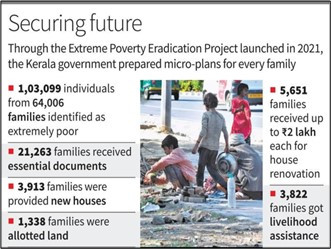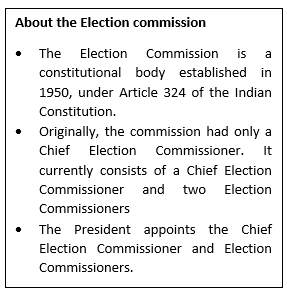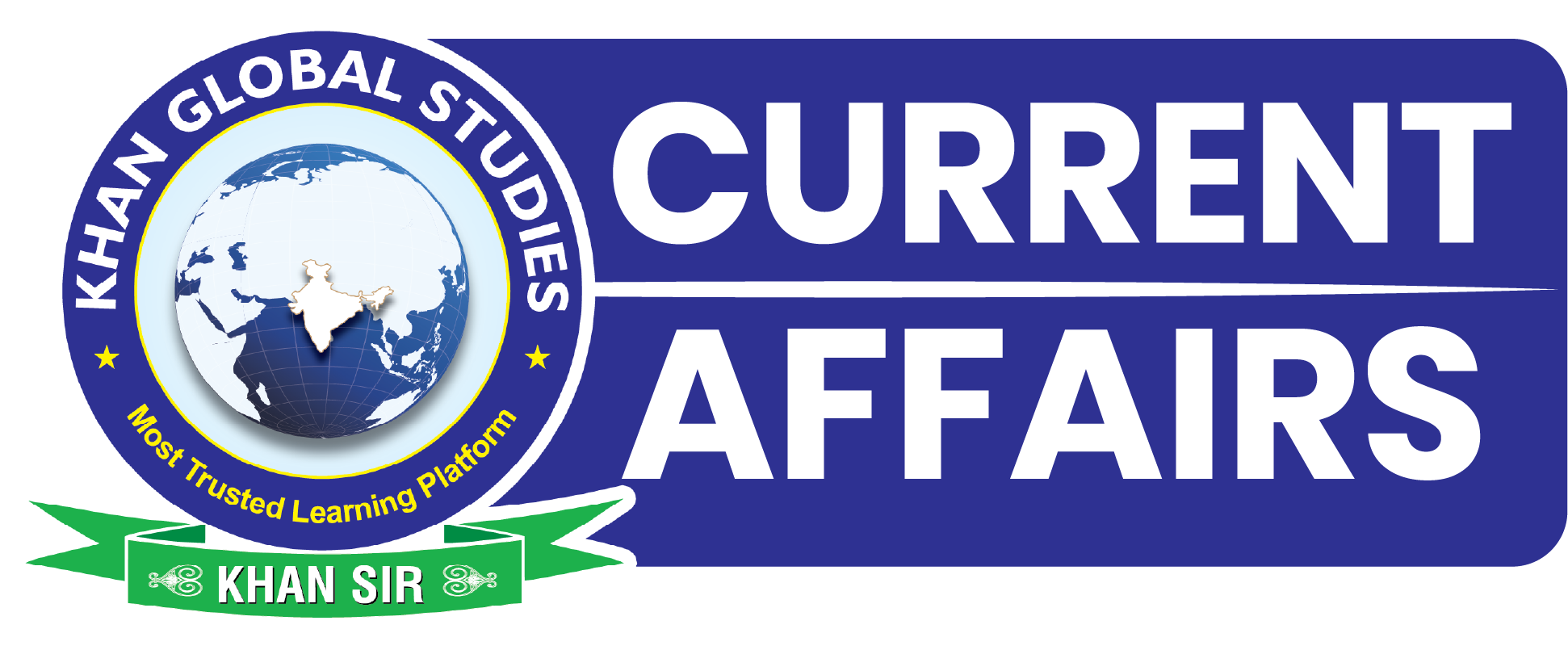Kerala to be first State ‘free of extreme poverty’
Context:
Kerala will officially declare itself free from extreme poverty on November 1, 2025, in Thiruvananthapuram, marking a historic achievement in social welfare and inclusive governance.
More on the News

- The declaration follows a four-year Extreme Poverty Eradication Project, launched in 2021.
- The state identifies ‘extreme poverty’ through multidimensional parameters such as access to food, health, shelter, and income, rather than a fixed poverty line.
- The initiative aimed to identify and uplift families in extreme poverty through targeted interventions addressing both immediate and long-term needs.
- According to a 2021 NITI Aayog study, Kerala had the lowest poverty rate in India at 0.7%, forming the basis for this focused programme.
- The declaration coincides with Kerala’s formation day.
- Kerala’s formation day is celebrated annually on November 1, 1956. This date is celebrated as Kerala Piravi, which translates to “the birth of Kerala,”.
Significance of the Achievement
- Kerala becomes the first Indian state and only the second region globally, after China (2020), to eradicate extreme poverty.
- The achievement reflects the success of decentralised governance and targeted welfare programmes in addressing multidimensional poverty.
- It underscores Kerala’s people-centric governance model, where social inclusion, health, housing, and education are viewed as rights rather than welfare measures.
DAC Approves ₹79,000-Crore Projects to Strengthen Armed Forces
Context:
Recently, the Defence Acquisition Council (DAC) has approved a series of capital acquisition proposals worth about ₹79,000 crore to enhance the operational and combat capability of the Indian Armed Forces.
More on the News
- The approvals cover procurements for the Indian Army, Navy, and Air Force.
- These include advanced weapon systems, platforms, and support equipment aimed at enhancing lethality, mobility, intelligence-gathering capabilities, and overall defence preparedness across multiple domains.
Details of the Approvals
Indian Army:
- Approved acquisitions include the Nag Missile System (Tracked) Mk-II (NAMIS), Ground Based Mobile ELINT System (GBMES), and High Mobility Vehicles (HMVs) with Material Handling Cranes.
- The NAMIS (Tracked) will enhance the Army’s capability to destroy enemy armoured vehicles, bunkers, and fortified positions.
- The GBMES will provide round-the-clock electronic intelligence on enemy emitters, while HMVs will strengthen logistic support across varied terrains.
Indian Navy:
- Acceptance of Necessity (AoN) was granted for the procurement of Landing Platform Docks (LPDs), 30 mm Naval Surface Guns (NSGs), Advanced Light Weight Torpedoes (ALWTs), Electro-Optical Infra-Red Search and Track Systems, and Smart Ammunition for 76 mm Super Rapid Gun Mounts.
- The LPDs will enhance amphibious warfare capability and enable joint operations with the Army and Air Force.
- They will also expand India’s capacity for peacekeeping, humanitarian assistance, and disaster relief (HADR)
- The ALWTs, indigenously developed by DRDO’s Naval Science & Technological Laboratory (NSTL), will strengthen undersea warfare capabilities against conventional, nuclear, and midget submarines.
Indian Air Force:
- AoN was approved for the Collaborative Long Range Target Saturation/Destruction System (CLRTS/DS) and related systems.
- The CLRTS/DS will provide autonomous take-off, landing, navigation, target detection, and precision payload delivery capabilities, enhancing long-range engagement efficiency and technological edge.
International Convention against Doping in Sport
Context:
Recently, India has been re-elected as the Vice-Chairperson of the Bureau for the Asia-Pacific region at the 10th Session of the Conference of the Parties (COP10) to the International Convention against Doping in Sport.
More on the News
- The 10th Session of the COP10 was held from October 20–22, 2025, at UNESCO Headquarters in Paris.
- The meeting marked the 20th anniversary of the Convention, which serves as the only legally binding international framework promoting integrity and eliminating doping in sport
- India was re-elected as the Vice-Chairperson of the COP10 Bureau for the Asia-Pacific (Group IV) for the 2025–2027 term.
- Azerbaijan was elected Chairperson of the Bureau, while Brazil, Zambia, and Saudi Arabia were elected Vice-Chairs for their respective regional groups.
- India successfully proposed amendments to promote harmonisation and visibility in education-related initiatives by integrating the Values Education through Sport (VETS)
- The VETS approach aims to strengthen the transmission of ethics, values, and integrity through sport among youth, sport organisations, and society at large.
About the International Convention against Doping in Sport
- It is a UNESCO multilateral treatythrough which States agree to adopt national and international measures to prevent and eliminate doping in sport.
- It was adopted on 19 October 2005 during the 33rd session of UNESCO’s General Conference and entered into force on 1 February 2007.
- Initial ratification by 30 countries, the Convention now has 192 States Parties, making it UNESCO’s second most ratified treaty.
ECI mandates labelling of AI-generated content in political campaigns
Context:
Ahead of the upcoming Bihar Assembly election, the Election Commission of India (ECI) issued an advisory to all recognised political parties regarding the responsible use and disclosure of synthetically generated and AI-generated content during election campaigns.
Key Highlights of the Advisory

- The ECI noted the growing misuse of hyper-realistic synthetic media portraying political leaders making false or electorally sensitive statements, which undermines the level playing field and distorts fair competition during elections.
- To address this, the ECI has made it mandatory for all AI-generated, synthetically altered, or digitally enhanced campaign materials to be clearly labelled with terms such as “AI-Generated,” “Digitally Enhanced,” or “Synthetic Content.”
- These disclosure labels must cover at least 10% of the visible display area in visual content or the first 10% of the duration in audio content to ensure visibility and clarity.
- For video material, the label must appear at the top of the screen throughout the required duration to inform viewers of its synthetic nature.
- Disclosure of Source: Political parties, candidates, and campaign representatives must include the name of the entity responsible for generating the synthetic content in the metadata or accompanying caption.
- Prohibition of Misleading Content: The advisory strictly prohibits the creation, publication, or forwarding of any synthetic media that misrepresents a person’s identity, appearance, or voice without consent or in a manner that could mislead or deceive voters.
- Timely Removal of Misinformation: Political parties must remove any misleading or unlawful synthetic content detected on their official handles within three hours of being reported or noticed.
- The advisory, issued under the ECI’s powers conferred by Article 324 of the Constitution, reinforces compliance with the Information Technology Rules, 2021, and builds on the Commission’s earlier advisories issued in May 2024 and January 2025 on ethical social media use and AI content labelling.

